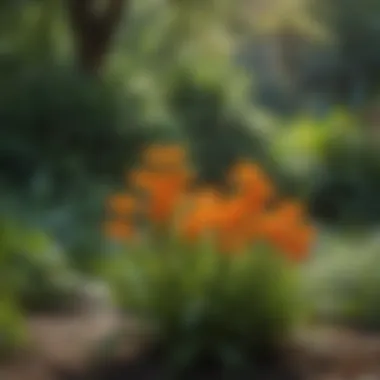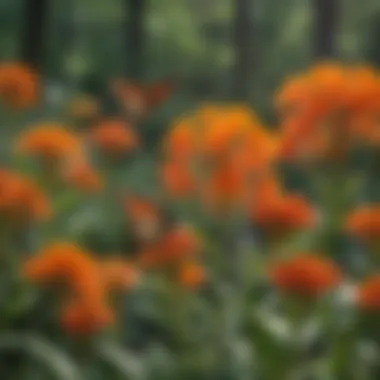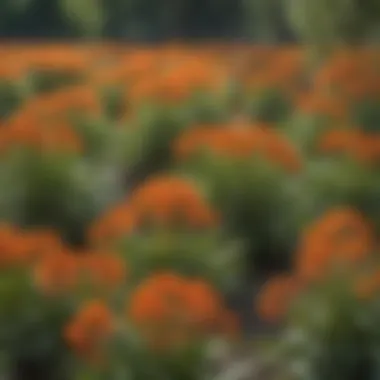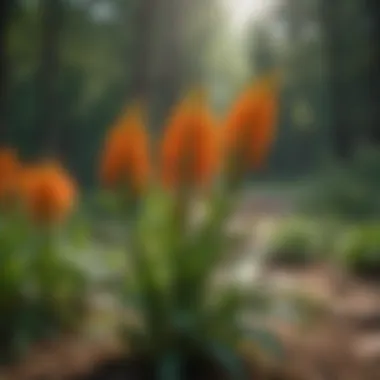Where to Buy Butterfly Weed Plants for Your Garden


Intro
Butterfly weed plants, scientifically known as Asclepias tuberosa, are essential for attracting various pollinators such as butterflies and bees. These vibrant perennials are not merely decorative; they actively contribute to the health of local ecosystems. As awareness of the need for biodiversity increases, the demand to acquire butterfly weed plants has also surged. This article offers a comprehensive guide on where to purchase these plants, emphasizing the significance of supporting local flora.
Striking a balance between aesthetics and ecological responsibility is vital. Choosing to incorporate butterfly weed into your garden is a step towards enhancing the natural habitat. Not only do these plants provide nourishment for pollinators, but they also create vibrant landscapes.
As we navigate through the avenues for purchasing butterfly weed plants, consider the practical aspects of your choices. These may involve availability, health of the plants, and their suitability for the environment.
In this guide, we will explore all these elements, culminating in informed decision-making, enhancing both your garden and the local ecosystem.
Prelims to Butterfly Weed
Butterfly weed, scientifically known as Asclepias tuberosa, is a perennial plant renowned for its vibrant orange and yellow flowers. This species plays a significant role in attracting butterflies and other pollinators, thus contributing to the biodiversification of garden and natural landscapes. Its importance lies not only in its aesthetic appeal but also in its ecological benefits.
Importance in Ecosystems
The role of butterfly weed in ecosystems is multifaceted. It serves as a crucial nectar source for a wide variety of pollinators, including monarch butterflies, native bees, and hummingbirds. As a host plant, it supports the life cycle of the caterpillars of the monarch butterfly, ensuring their survival and reproduction. Furthermore, butterfly weed contributes to soil health by stabilizing the soil with its deep root system, which helps to prevent erosion. The plant also attracts beneficial insects, which can help control pests, promoting a healthier garden environment.
Characteristics of Butterfly Weed
Butterfly weed is distinguished by its tough, hairy stems and clusters of bright blossoms that typically bloom from late spring to early summer. The leaves are narrow and lance-shaped, and the plant can grow between 1 to 3 feet in height. It is well-suited for dry, sunny conditions and does not require excessive watering, making it ideal for xeriscaping and low-maintenance gardens. Its ability to thrive in poor soil conditions further highlights its resilience. Additionally, the plant is not only beneficial for pollinators but also offers the gardener a low-maintenance option that brings vibrant color and life to the landscape.
In summary, understanding the importance and characteristics of butterfly weed is crucial for those looking to cultivate this plant in their gardens. Knowledge of its role in ecosystems and its unique features can guide individuals in making informed decisions regarding purchasing and planting.
Understanding Butterfly Weed Varieties
Butterfly weed, scientifically known as Asclepias tuberosa, is a species crucial not only for its striking appearance but also for its role in supporting local ecosystems. Understanding the different varieties of butterfly weed is essential for anyone interested in gardening or ecological restoration. Each variety may display unique characteristics, such as flower color, height, and adaptability to different soil types or climates. This knowledge can aid in decision-making when sourcing these plants, ensuring that they will thrive in specific environments and successfully attract pollinators.
Common Species
When considering butterfly weed, it's important to recognize that there are several species and cultivars available. Common species besides Asclepias tuberosa include Asclepias incarnata (swamp milkweed) and Asclepias syriaca (common milkweed). Each species serves a unique function in a holistic garden design.
- Asclepias tuberosa: This species is characterized by its bright orange to yellow flowers and is well-known for attracting butterflies, particularly monarchs. It tends to thrive in well-drained, sandy soils and prefers full sunlight.
- Asclepias incarnata: Often called swamp milkweed, it prefers wet soils and produces pink to purple flowers. It is vital for regions with higher moisture levels, providing a crucial habitat for specific pollinators.
- Asclepias syriaca: This species features large clusters of purple flowers and is more tolerant of varied soil conditions. It's particularly beneficial for larger gardens or naturalized areas, offering a reliable food source.
Native vs. Non-Native
Choosing between native and non-native varieties of butterfly weed is a critical factor when planning your garden. Native species are adapted to local environmental conditions and have co-evolved with native wildlife. They generally require less maintenance and are more resistant to local pests and diseases.
In contrast, non-native varieties might introduce new traits but can also pose risks to local ecosystems. When selecting plant sources, consider the following points:
- Benefits of Native Species:
- Challenges with Non-Native Species:
- Greater resilience to local climatic variations.
- Support for native insects and pollinators, enhancing biodiversity.
- Reduced need for irrigation or pest control measures.
- Possible competition with local flora.
- Potential to attract non-native pests.
- Less engagement with local pollinator species that may not recognize them as a food source.
In summary, understanding butterfly weed varieties, specifically the distinction between common species and native versus non-native options, equips gardeners with the knowledge needed for sustainable and effective landscaping choices. As you delve into the purchasing options for butterfly weed, keeping these considerations in mind will help ensure that your plants thrive and contribute positively to the ecosystem.
Where to Purchase Butterfly Weed Plants
Finding the right source for butterfly weed plants is pivotal for anyone looking to cultivate this essential species. Butterfly weed is not only aesthetically pleasing but also supports critical pollinator populations. Thus, selecting a reputable vendor can determine not just the success of your gardening efforts but also the impact on local ecosystems. This section will delve into various purchasing avenues, emphasizing their unique contributions to both practicality and environmental stewardship.
Local Nurseries


Local nurseries often offer a sense of community and personal touch. When seeking butterfly weed plants, these smaller operations frequently provide knowledgeable staff who understand regional climate conditions. They often stock native varieties that thrive in specific local environments, ensuring that your plants are well-adapted to the area’s soil and climate.
When visiting a local nursery, consider asking the staff about the source of their plants. This can give insights into their quality and care. Furthermore, you can observe the plants' health firsthand before making a purchase. Healthy plants should look vibrant, with no signs of pests or disease. Supporting local businesses adds to the community, fostering a network of native plant enthusiasts.
Online Retailers
Online retailers have expanded the reach for butterfly weed plants significantly. E-commerce platforms provide a broad selection of species, often more than local nurseries can stock. Websites such as Etsy and Amazon feature various sellers offering butterfly weed plants, sometimes with detailed descriptions of growth requirements and care tips.
However, when buying online, it is essential to consider several factors. Read customer reviews to gauge the reliability of the seller. Check their return policy in case the plants do not meet your expectations. Also, shipping conditions significantly affect plant health. Opt for sellers that prioritize proper packaging and timely shipping to enhance the chance of receiving a healthy plant.
Specialty Garden Centers
Specialty garden centers typically focus on native and unique plant species. They can be an excellent source for butterfly weed plants, often carrying specific varieties that might not be available at larger chains. These centers may also offer additional resources, such as workshops and guides on creating butterfly-friendly gardens. Inquiring about their gardening programs can provide valuable knowledge needed for successful cultivation.
Moreover, the expertise of staff can help you select plants appropriate for your planting goals. They can advise you on the best practices for care, ensuring that your efforts to attract local pollinators are optimally successful.
Native Plant Societies
Native plant societies serve as a significant resource for obtaining butterfly weed plants. These organizations are dedicated to promoting the use and conservation of indigenous flora. They often host plant sales, offering locally sourced plants that can adapt well to native habitats. Purchasing from these societies not only gives you access to healthy plants but also supports conservation efforts.
Being a part of such a community also provides an opportunity for education. Engaging with passionate individuals who share your interest can enhance your understanding and appreciation of local ecosystems. Furthermore, they offer valuable insight into the ecological role of butterfly weed, allowing for a more informed gardening experience.
Evaluating Quality When Buying Plants
Understanding the quality of butterfly weed plants is crucial for anyone embarking on a gardening journey. Growth success often hinges on the initial health of the plant. If you acquire weak or unhealthy specimens, it might lead to poor establishment and eventual failure in your garden. Therefore, being proficient in identifying quality plants can save time, effort, and resources.
To ensure you buy the best butterfly weed plants, there are some key factors to consider:
- The vitality of the plant: A vigorous plant is more likely to survive and thrive in your garden.
- Resistance to pests and diseases: Healthy plants are usually less susceptible to infestations and illnesses.
- Improved growth potential: Quality plants adapt better to their environment and flourish more robustly.
Evaluating quality directly influences outcomes in your butterfly garden, reinforcing the importance of careful selection.
Signs of Healthy Plants
When assessing the health of butterfly weed before purchase, there are several visible signs to look for. First, consider the foliage. It should be lush and vibrant, without discoloration or signs of wilting. Any yellowing leaves may indicate nutritional deficiencies or overwatering. Lightly check the leaves for pests, such as aphids or spider mites. Their presence can hinder the plant's growth and overall health.
Next, observe the roots if possible. A healthy root system is often white and firm, while dark or mushy roots suggest rot, a warning sign of poor plant quality.
Additionally, the overall structure of the plant matters. Look for a strong central stem that holds up the leaves. A plant that is leggy or overly stretched might not be as vigorous. Here are some signs to pay attention to:
- Healthy, vibrant leaves
- Firm, white roots
- Sturdy growth habit
With these factors in mind, you can confidently choose promising plants for your garden.
Understanding Plant Labels
Plant labels provide essential details about your butterfly weed purchase. These labels serve as a quick reference guide and can influence your plant care practices. Clear labelling typically contains scientific names, growing recommendations, and potential pest concerns. Knowing the accurate botanical name is important for further research on the specific species.
A well-structured label might show aspects like:
- Sunlight Requirements: Indicates whether the plant requires full sun, partial shade, or complete shade.
- Watering Needs: Provides insights into how often the plant should be watered and whether it can tolerate dry conditions.
- Mature Size: Lists expected height and spread, which is valuable for planning your garden layout.
Being knowledgeable about these elements will help you make informed decisions and better care for your plants. Ultimately, understanding plant labels can significantly affect the success of your butterfly weed in your garden.
Pricing Considerations


Understanding the pricing considerations when buying butterfly weed plants is crucial for any gardener or conservationist. Awareness of cost can help in making informed decisions, planning a budget, and ultimately, ensuring the success of a butterfly garden. This section will analyze the importance of different pricing factors, allowing you to navigate the nuances involved in purchasing these vital plants.
Cost Variance by Source
The price of butterfly weed can vary significantly based on several factors such as the source of purchase, the variety of the plant, and even the geographical location of the seller.
- Local Nurseries: In-person nurseries might charge a premium for the convenience and the quality assurance that come with live plants. The price usually reflects the effort in growing and maintaining healthy specimens. Factors like local demand and supply can affect prices as well.
- Online Retailers: Websites such as Burpee or American Meadows often provide a wider selection. Prices here can be lower compared to local stores due to lower overhead costs. However, shipping fees can sometimes offset these savings, leading to varying total costs.
- Specialty Garden Centers: These centers might be pricier due to their focus on native plants and sustainability, an appealing factor for eco-conscious buyers. They often provide high-quality plants and expert advice, justifying their prices.
"When considering where to purchase butterfly weed, do not only evaluate the upfront cost; consider the entire scope of what comes with the plant, including support and expertise."
Understanding the differences in sourcing and how they translate to pricing can allow you to choose the best option for your needs.
Budgeting for a Butterfly Garden
Creating a budget for a butterfly garden involves more than just the purchase of plants. To ensure a beautiful and functional butterfly habitat, you must take into account several factors:
- Initial Plant Costs: Identify the price ranges for butterfly weed and other necessary plants. Compare local nurseries, online suppliers, and special garden sales.
- Soil and Amendments: Quality soil is crucial for plant health. Be prepared to invest in nutrient-rich soil or amendments if your garden's natural soil is inadequate.
- Maintenance Costs: Consider the ongoing costs such as watering, fertilization, and pest control. A well-maintained garden requires regular attention and budget allocation.
- Tools and Equipment: Depending on what you already own, you may need to purchase gardening tools. Budget for initial investments in items like shovels, watering cans, and possibly raised beds.
- Education and Resources: Consider attending workshops or buying books on butterfly gardening to enhance your knowledge. Investing in education can lead to better gardening outcomes.
By planning effectively and adapting your budget to your garden's unique requirements, you make the endeavor both economically sound and ecologically rich.
Timing Your Purchase
Timing plays a crucial role in successfully acquiring butterfly weed plants. Understanding the right time to make your purchase can enhance plant viability and support healthy gardening practices. This guide will explore the best seasons for buying these essential plants and provide insights on the optimal timing for planting them in your garden.
Best Seasons for Buying
Purchasing butterfly weed plants requires attention to seasonal trends in availability and health. Typically, the best times to buy butterfly weed are in early spring and early fall. During spring, nurseries are freshly stocked with new plants. The plants are usually healthy and vibrant, making it easier to select quality specimens. Early fall is another key buying season. At this time, many nurseries offer discounts as they prepare to clear out inventory before winter.
When buying in fall, pay attention to the region. In southern areas, fall purchases are often viable. However, in northern climates, the growing season may end beforehand, which could affect planting times.
Consider the following advantages of buying in these seasons:
- Spring: Optimal plant health, vibrant colors, and greater selection.
- Fall: Discounts on plants and opportunities to establish roots before dormancy.
Timing for Planting
Once you acquire butterfly weed plants, the timing for planting is equally important. After purchasing, it’s typically advisable to plant them soon after. Early spring is an excellent time for planting. This allows the plant to establish its roots before the heat of summer. If you purchase in fall, plant them early enough for the roots to settle before the ground freezes.
To summarize, proper timing enhances the chances of butterfly weed plants flourishing in your garden. Selecting the right season for purchase and planting will ensure that you make the most of your butterfly weed endeavor. The focus should always be on ensuring optimal growth and establishing a healthy butterfly garden.
Considerations for Planting and Care
When acquiring butterfly weed plants, it is essential to understand the considerations for planting and care. This section is significant because it outlines the necessary steps to ensure the successful establishment and longevity of the plants. Knowing the right conditions and care requirements assists gardeners in maximizing the benefits that butterfly weed can offer to local ecosystems. Adhering to these best practices promotes healthy growth, contributing to the vitality of gardens and habitats.
Soil Requirements
Soil is a fundamental factor that influences the health of butterfly weed plants. This species thrives best in well-draining soils, particularly sandy or loamy types. The pH level also plays a role; butterfly weed prefers a slightly acidic to neutral pH, typically ranging from 6.0 to 7.0.
Consider the following aspects when preparing the soil:
- Drainage: Ensure that there is good drainage in the planting area. Butterfly weed does not tolerate waterlogged conditions.
- Nutrient Levels: Although butterfly weed is relatively low-maintenance, it benefits from moderate fertility. Incorporating organic matter before planting can improve nutrient content.
- Compaction: Avoid compacted soil, which can hinder root development. Loosen the soil to foster better growth conditions.
Creating an environment that meets these soil requirements facilitates healthier plants, enhancing their ability to attract pollinators and support the ecosystem.


Watering Needs
Watering is a critical part of establishing butterfly weed. After planting, regular watering is important until the roots settle. However, overwatering can be detrimental. Here are some guidelines:
- Initial Watering: Water the plants deeply after planting to help them establish. This promotes a strong root system.
- Frequency: Once established, butterfly weed is drought-tolerant. Water sparingly during dry spells, allowing the soil to dry out between waterings.
- Observation: Pay attention to the plants. Signs of inadequate watering include wilting or discoloration of leaves.
By understanding the watering needs of butterfly weed, gardeners can optimize plant health while conserving water resources.
Sunlight Preferences
Light exposure is another important aspect for the successful growth of butterfly weed. This plant thrives in full sun, which is critical for its flowering and overall development. Consider these points regarding sunlight:
- Duration: Aim for at least six hours of direct sunlight daily. This is necessary for optimal growth and blooming.
- Shade: While butterfly weed can tolerate partial shade, excessive shading can lead to leggy growth and fewer flowers.
- Location: Choose a location that is shielded from strong winds, as this can protect delicate flowers and stems.
By meeting the sunlight preferences of butterfly weed, gardeners not only enhance the aesthetic of their gardens but also ensure the plants provide essential habitats for pollinators.
It's essential to recognize that healthy butterfly weed contributes positively to ecological health by attracting a variety of beneficial insects, thereby fostering a more vibrant ecosystem.
Conservation and Ethical Considerations
Conservation and ethical considerations pertain to the responsible sourcing and planting of butterfly weed. As environments change and habitats diminish, understanding how our choices in plant acquisition impact ecosystems becomes vital. This article emphasizes that when selecting butterfly weed plants, one must look beyond aesthetics. The aim is to engage in practices that support biodiversity and local ecology.
Sustainable Sourcing
Sustainable sourcing is central to conservation efforts. Opting for butterfly weed plants that are cultivated in a way that minimizes environmental impact promotes healthy ecosystems. When buying plants, consider the following aspects:
- Local Vendors: Supporting local nurseries and garden centers encourages sustainability. These businesses often grow plants suited to the region, reducing transport emissions and promoting genetic diversity.
- Native Plant Societies: These organizations play a pivotal role in conservation by propagating native species. Purchasing from them ensures that the plants are true to local genetics, fostering resilience in the ecosystem.
- Avoiding Imported Plants: Imported plants can bring invasive pests and diseases. Thus, choosing local varieties ensures healthier plants and mitigates risks to local flora.
Ensuring sustainability means using resources that prioritize the health of our natural surroundings.
Impact of Invasive Species
Invasive species pose a significant threat to butterfly weed and its ecosystem. When non-native plants are introduced, they can outcompete local species for resources. The consequences include:
- Biodiversity Loss: Invasive species can diminish overall plant diversity, destabilizing ecosystems and altering habitat for various pollinators that rely on native plants.
- Ecosystem Disruption: The introduction of invasive species often changes soil chemistry and nutrient availability, negatively impacting the growth of existing flora, including butterfly weed.
- Competing Resources: These invasive plants may take up space and nutrients that native species need, which can lead to a decline in local populations of butterfly weed.
In this regard, promoting the purchase of native butterfly weed plants helps combat the spread of invasives. By planting species that are naturally adapted to their environment, we can actively participate in maintaining the integrity of local ecosystems.
"The choice we make regarding plant sourcing has the power to shape the future of our local environments. Embracing sustainability is not merely a positive action, but a vital necessity for ecological integrity."
End
In this article, the focus has been on the various avenues available for purchasing butterfly weed plants, highlighting their significance not only in personal gardens but also in contributing to broader ecological health. The exploration of local nurseries, online retailers, specialty garden centers, and native plant societies has revealed the myriad of options that individuals have. Moreover, understanding the quality of the plants, pricing variations, timing for purchase, and essential care considerations has underscored the multifaceted nature of engaging with these plants.
Summarizing Key Points
- Diverse Purchase Options: There are various sources to buy butterfly weed, including local nurseries and online platforms, providing flexibility depending on individual preferences.
- Quality Evaluation: It’s crucial to identify healthy plants through visible signs. This ensures that the plants will establish well and thrive over time.
- Consider Financial Aspects: The cost associated with butterfly weed can vary widely. It is advised to budget in advance, prioritizing quality over merely low prices.
- Optimal Timing: The best times to purchase and plant will yield better results. Seasonal knowledge can significantly impact plant establishment.
- Environmental Impact: Understanding sustainable practices when sourcing plants can help in preserving local ecosystems.
This summary encapsulates the information one must bear in mind when seeking butterfly weed plants and emphasizes the larger goal of bolstering local biodiversity through informed gardening practices.
Encouragement to Engage with Native Flora
Engaging with native flora is essential for creating sustainable ecosystems. Butterfly weed, specifically, is more than just a simple addition to a garden. It provides essential habitat for pollinators, striking a balance between aesthetic appeal and ecological necessity. By making informed choices, individuals can play a significant role in conservation.
Those who plant butterfly weed not only enhance their garden but also contribute to the health of the environment, supporting food webs and local biodiversity. Consider joining native plant societies or participating in local conservation efforts. These engagements can offer personal satisfaction, as well as community benefits.
This movement towards more sustainable gardening is not just a trend; it's a step forward in promoting a healthier relationship with nature. By choosing to include butterfly weed in your garden, you are making a statement about the importance of native plants and their role in supporting wildlife.
"Every plant you add to your garden is a small step toward a more balanced ecosystem."
Embrace the opportunity to foster environment-friendly practices through your gardening choices. It is a rewarding endeavor that has implications well beyond the garden fence.



